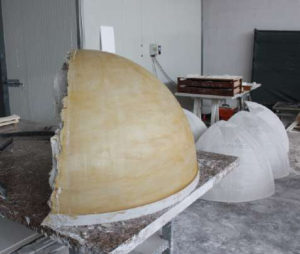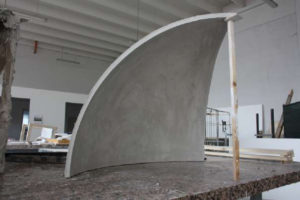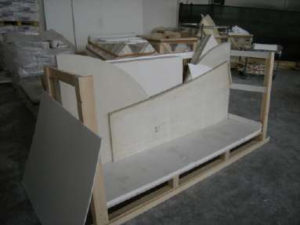Plaster decorations production phases
The plaster decorations production takes place in house in the company’s laboratories that are fully-equiped by our high skilled and decorations expert craftsmen. The production cycle can be divided into different phases, according to the element to be created.


On the basis of the project drawings, the samples of the decorations are created in our laboratory.
- Drawing of the decoration in scale 1.1 in order to faithfully reproduce even the smallest details. Working drawings show both the decoration’s layout and its section together with its maximum thickness.
- Modelling of the decoration by using kaolin in a plastic state in order to facilitate its workability. Once the model is ready, it is placed inside a air circulating drying oven set at 80° C for at least twelve hours.
- Creation of the mould’s base, after having previously applied a kaolin layer about 10 mm. thick on the sample. Once the gypsum is dry, the mould is detached from the sample, which must be cleaned of the kaolin layer before it starts setting.
- Repositioning of the plaster’s base on the sample, after having drilled a hole on it, through which silicone rubber is then cast. Once it is dry, the final shape of the sample will be obtained.


On the basis of the project drawings, the shapes or the so called “negatives” of non-decorated items are created in laboratory.
- Creation of the mould’s wooden base and placement of the base onto a sliding carriages table.
- Casting of extremely liquid scagliola gypsum on the top of the base; by sliding the galvanized steel shape on the sliding carriages, the gypsum becomes smooth.
- Once the surface is very smooth, the gypsum has to be kept drying up for at least twelve hours.
- Addition of an impregnant in order to increase the smoothness and hardness of the surface.
- Once the impregnant is dry, a very thin fat layer is added in order to facilitate the item’s detachment from its shape.


This is the phase where decorations are actually created. Casting of gypsum must take place within short time as the plaster’s workability is quite limited once the gypsum has been cast. IAD avoids using retardant substances mixed with gypsum, as they might provoque deformations while the gypsum is setting and therefore damaging the decorations.
In the case of decorations and frames longer than two metres and whose sections are longer than one metre, the presence of two or more people working on the same shape is required. Four castings of plaster gypsum are made for each item:
- the first casting must be very liquid in order to adhere perfectly to every little cavity of the sample;
- the second casting is more plentiful and the mixture is more solid. Before it starts drying up on the surface, manila natural fiber is applied on the top;
- the third casting occurs immediately after and similarly to the previous one. Then, galvanized steel rods of 4mm diameter are inserted; if there are curved elements, then rods will be curved in the same manner. On the top of the rods, an additional layer of manila fiber is added in order to ensure their inclusion and stability;
- the fourth and last casting is a solid mixture, just like the two previous ones.

After the last casting, it is recommended to wait at least one hour for the mixture to set and to reach the best degree of hardness and resistance. Then the item must be slowly detached from its shape in order to avoid damages of the surface in contact with the shape.
After which the item are placed on the top of carriages and then inside an air circulating drying oven set at 80° C for at least twenty-four hours, depending also on the size of the item, in order to increase its degree of impermeability.


The decorations are packed, placed into wooden cages according to their type and future location, and transported to the worksite. The various pieces constituting the decorations are numbered on the back according to the order of arrangement and in order to facilitate their replacement in case of damages occured during transportation or assembly. As it is not possible to have major storage areas in the worksite, trasportation of materials must be carried out in a gradual manner.


Frames and decorations are applied by using a gypsum based glue. In case of frames directly fixed on the wall, this has to be previously smoothed with scagliola gypsum. Heavy decorations are also fixed with anchors and bolts, which assure a perfect fixing. Once the elements of every single area are applied, the grouting and smoothing of the frames’ joints can be performed.




